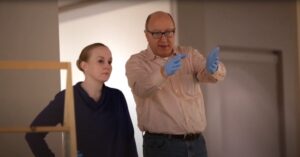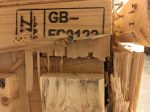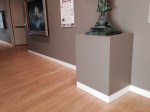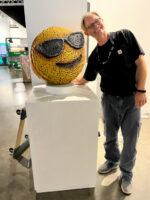Hello Trade Folk,
Here’s a little behind the scenes for opening up crates, condition reporting, laying out the art, and hanging techniques. There’s a pretty wide swath of activities in this video, and like many of us, these peeps wear multiple hats in the same day. Side note: I did a LinkedIn survey about the “hats” we wear. Video is below if you want to jump to it.
1 hat, focused – 11%
2-3 hats, juggling in control – 31%
3-5 hats, whaaaat is it open?! – 29%
5+ hats, RIP, you did too much – 29%
So here are the lessons, tips, and tricks I’ve gleamed from the Cedar Rapids Museum of Art’s video. Please keep in mind, we all have our level and capacity (budget and labor). Contrast the work done here with, say, the MOMA. Few can rise to MOMA’s level, don’t hold yourself to that. There is no judgment here, just observations that I hope will elevate all of us.
 KEEP THE UNPACKING ORDER (0:05)
KEEP THE UNPACKING ORDER (0:05)
You’ll notice right from the start a great option there, to turn the lid in a logical way that’s easy to replicate when you put the lid back on. I would guess that they’ll probably pull the foam out in the same way for the same reason. That’s a good habit. It looks like they might not work together all the time because they’re a little unclear which way they’re going to flip and that’s okay.
ACCLIMATING AND CLIMATIZING THE WORKS OF ART (0:28)
If you can it really makes a difference, especially with the more fragile works. It’s often a contractual stipulation. It helps the art no matter the age of the piece, but especially the older works. If you have time please consider giving the work a rest at least 24 hours to acclimate to your environment.
TAPE AND TABS (1:07, 2:03, & throughout)
Okay, so this is no knock on them. The previous venue packed with clear tape. I know sometimes we do what we have to with what we have, but please, if you’re buying tape buy the brown/tan packing tape. It just really helps locate ALL the tape so there’s no accidental folding back of tape onto the artwork.
Also, consider some “courtesy tabs”. To do this, fold over about a half inch of the end of the tape edge. This allows others, like you, to easily grab that edge and get it rip off. It’s awesome and easy to do. I’ll do a little article on the work and hand flow for doing courtesy tabs easily.
PRESCIOUS WALLS (0:12 &1:40)
You’ll notice they’re not using anything under the paintings. It looks like carpet. So there’s a nice soft touch for the frames at the floor. But a quick tip here, you can use some thin ethafoam behind the frames corners at the top. It offers a little protection for the frame itself and saves your walls from being scuffed. That’s always a nice thing.
Some places use foam blocks for every single piece. I guess it depends on your situation and capacity. We use blankets on the wood floors, and a scrap of 1/8” ethafoam behind each from corner. It’s really just some scrap foam, practically trash that may be lying around your shop this very minute.
HELP WHEN HANDLING WORKS OF ART (1:54)
They’re doing a good job of having multiple hands at the same time. They’re working with each other to make sure that there’s always a hand on the work while the plastic is coming off. Again, we have to do what we have to do sometimes, but if you can have a spotter that’s a nice and safe way to do it. Plastic can make things a little slippery and two people is a great option.
DEBRIS WHEN UNPACKING ART (2:10)
When the plastic comes off give the process a moment, lay it down, look for a little debris in there. It could be anything that might have fallen off – the frame or the canvas. They talk about finding little bits of things in the plastic and bringing the courier over. It’s a good habit even if there isn’t a courier of course.
TETHER TOOLS WHEN INSPECTING ART(1:20)
Nice little pro move by the courier to put the wrist strap from the flashlight around her wrist, but also between her thumb and first finger. So if, god forbid, she let go of the flashlight during inspection it wouldn’t fall far. If it were just around her wrist it would fall pretty far, likely striking the canvas. Tethering tools when working over art is a great idea, it offers a bit of security and peace of mind. It’s like having a seat belt, you have it just in case.
LIFTING AND HANDLING WORKS OF ART (2:40 & 4:30)
Team lifting. I like to talk about the Little Engine that could. You know the story, I think I can, I think I can, I think I can. If you think you can then don’t do it. Only do it if you know you can.
So doing a team lift is a great way to ensure that things move well. It’s important that the work doesn’t twist during a move, it’s also important that your body doesn’t twist awkwardly during a move. Take care of yourself always.
It’s good to make sure you’re talking to your partner, to know which way they’re going to go next. If in doubt, take a break and rest your grip. Lastly, having a clear path to your destination is also a wise move.
LAYOUT & DESIGN FOR MUSEUM EXHIBITION(5:05)
We don’t get a full layout of the show in the video, nor could be fully reason where works would look best from video. That can only be fully realized with the works in front of us. From the one shot we get (5:47) I like that she’s created some rhythm and broken up some of the bigger pieces, the solo horizontal is in the middle and the verticals are three and three to either side.
I guess you could also pair those four smaller ones (2+2), one technique is to kind of bump them together with a 4”-6” gap instead of everything equaspaced. If those four were two pairs instead everything could have a little more space.
At the same time the two pairs get a little more body and girth, especially since those works on paper have a lot of mat around them. They could then stand up better to the larger works around them while also giving the whole wall more space between things
FRACTIONS MATTER – MATH FOR HANGING ART (6:12)
What does this sticky note tell us and what is missing? It looks like 7.5” down on both sides. I’m assuming then that those numbers are down to the D-rings otherwise why would you need two numbers. 48 is probably the height of the work and different number in from the edges to the D-rings.
It looks like the photographer snapped a pic before the math was complete. Side note: When hanging art with a partner I love doing the fractional math in my head when I’m taking the dims and feeding them to the other handler whose writing it all down. I’ll give my number and see if I’m correct. Nerdy fun.
I might suggest to CRMoA that scratch paper and clip board would be slightly more economical than a sticky note and blue tape for each piece. Just a thought. Pennies I realize, but I love saving time and resources, love it!
The folks at CRMoA mention their center line, but do tell, What IS your center line (for each floor) for hanging CRMoA? Reader, what is yours, put it in the comment below…
PENCIL OR BLUE TAPE? (6:18)
Okay, we all have our ways of doing things I know, but blue tape may be a better option for marking your hook location. When your hook comes off, you’re going to have graphite on the walls, and that’s going to bleed through your paint.
Even if you’re using a semi-gloss paint and the pencil erases off nicely, at the very least it’s another step to making the walls beautiful and ready to go for the next show. I kind of prefer blue tape. It’s 100% reversible, and you can do many pieces in a row with the same pieces of tape.
2D HANGING HARDWARE (6:26)
Check out this hardware. I’ve seen it before, I don’t think I realized one could use a screw through this hanging hardware. These are probably pricier that standard J-hooks, but they have the benefit of being adjustable. We use a washer or two to tweak. SFMOMA uses other D-rings to bring it up or down. These however have quite a bot of travel for each J-hook. Does anyone know the name brand of these?
CONCLUSION
At 6:50 she concludes with something to the effect of “at the end we do it all again in reverse”, yep that’s the life you and I know. A lot of work, a lot of attention to detail, and a lot of keeping us and the art safe.
There are SO many steps to getting all this right.
I hope you gleamed a few choice nuggets. As always, MuseumTrade.org is open to your contributions, large or small. Send I your tips, tricks, successes, and yes your failures. Let’s get them all in one place so we can get better together. Head over to the contribution pagenow!
BONUS (0:14)
Check out @crate_stencils on Instagram if you liked seeing the variety of stencils on these crates. Not sure why, but I’m a fan of the variety that’s out there. There is definitely no standard, it’s the wild west!
TOOL TIP
THEIR VIDEO DESCRIPTION
Officials with the Cedar Rapids Museum of Art started planning more than three years ago for their latest attraction, “Across the Atlantic: American Impressionism Through the French Lens,” to be transported cross-country in time to commemorate the museum’s 125th anniversary. The exhibit includes works by impressionists Degas, Renoir, Pissarro, Mary Cassatt, John Singer Sargent and William Merritt Chase. Motorists unknowingly might have driven past the art collection in January, as it quietly was transported approximately 1,200 miles from its previous location, at the Appleton Museum of Art in Ocala, Fla. The paintings were packed with utmost care in 33 specialty boxes, wrapped in poly — a plastic wrap — and suspended with foam, and transported in a 72-by-53-foot fine-art truck, with temperature and humidity controls, additional shocks and inside panels, to which the boxes can be strapped.
Can’t do sound right now? Here’s the transcript:
Art shipping is its own kind of separate thing. So art shippers, the art has to travel in a climate controlled space and with extra shocks so that nothing is bouncing around back there. And of course, it’s all strapped down really, really carefully. So unloading, it is quite an undertaking. So it was a couple of hours to get everything unloaded from the truck.
And then art needs to acclimatize, because even just going through our loading dock is heated, of course, but even just going through from the truck out into the open air of the loading duck into our galleries can be shocking for a painting on panel or on canvas or works on paper. We started opening up all of the crates, some of which were for single pieces of art. And somehow I think the biggest one probably had five different pieces in it. So, yeah, we started opening up the crates, and there’s like a very extensive Excel document that’s the crate list. And so it lists what paintings should be in there and the dimensions and notes that we need to know.
So when you open up the crates, you’re checking that off the list of, like, okay, this one is here. Both the Courier and our museum register looked at all of the paintings. Just so we’re aware, if there are any problem areas or things that we should be aware of, there might be a loose wiggly spot on one of the frames, because all of these frames are original to the artwork, so they’re relatively old. So, you know, if there’s, like, a loose spot on the frame or if the painting is sliding a little bit, just so we’re aware of things to look out for while they’re under our roof. So, yeah, the Courier and our register look at every single painting.
And then I had a general idea of where everything was going to go in the galleries. And so once the painting had been okay and we needed to travel safely, we would lift it and place it in the gallery that it’s going to be hung in. So kind of getting things grouped where I wanted them to was a big step forward.
It’s a very exhaustive process. Obviously, these are all really beautiful, wonderful works of art. And we want to make sure that they’re traveling really well and that they’re still safe and nothing is happening to them with paintings. And this exhibition is mostly paintings. With paintings, there are several things.
Most of these paintings are over 100 years old. And so depending on the canvas or panel that it was on, the paint could be flaking in some area. There could be damage from an outside source. Some artists didn’t prime their canvases or their panels, and so they’re not thinking, how is this going to affect the work 100 years later? That’s not something that most artists take into consideration.
So there can just be some issues. Or if the painting was previously in a private collection, and there weren’t temperature and humidity controls around it. And all of that stresses. I mean, paintings, breeze, whatever environment they’re in, they’re taking that in and exhaling, too. So there are a lot of things that can happen, but all of these paintings are in really excellent condition.
So we’re very lucky. This career had been in Florida wrapping up the exhibition. And so then she went from Florida back to, I think, Pennsylvania for a few days and then flew out here. So she just saw these paintings when they came off the wall in Ocala, Florida. And so now she’s looking at them again.
So she has papers listing for every single work in the exhibition of like, okay, and she’ll have a diagram of like, all right, the frame is loose there, there’s some tuckering here. So she knows exactly what the problem areas are. And she’s seen these paintings so many times that she’s basically just checking up on things she knows might be issues and looking for other things. And we saw some things, too. The crates have a lot of, like, foam inside of them.
And so when we’re pulling these paintings out and they’re usually in nylon, not nylon, they’re usually in plastic bags, if we saw, like, some little detritus, we would call her over and be like, okay, is this something from the frame or the painting that we need to be aware of? Or in all of the cases, it was just some foam. Because if you keep pulling things in and out of foam that’s really tight against it, you’re obviously going to shave a little bit of the foam off every time. But it’s just stuff like that. You’re really careful and very attentive to everything.
A lot of these paintings are very large, and a lot of them have extremely large frames. So a lot of them were team lifts and things that one person could not, definitely should not, and could not, in my case, move by themselves. So we really did need that many people on hand because the crates themselves are really big and unwieldy. And as soon as we unpack the crate, we are trying to move it and get it out of our way so we could go through. There are 33 crates that were shipped for this exhibition.
And so in our gallery space, that ate up a lot of area. So we are trying to get them out of the way so we can move around a little bit more. So you have people unpacking crates, the courier and the registrar looking over the work to people generally moving the work from the table where the courier and the register looking at it, to the wall in the gallery where it’s going to go. So there are a lot of moving parts. I am in the middle of doing the layout for the exhibition, as I said when we were oncreating them, I was generally trying to get things that I knew I wanted to gather in the galleries that I had previously assigned them.
Definitely with no exhibition and certainly not one of this size, do you go in and be like, I’ll just figure it out when I see them. So I have spent a lot of time with graph paper and a checklist of the exhibition, deciding what themes I want together, how I want to group things size wise, what’s going to work on what wall, are the themes going to fit where I want them to? Do I need to switch galleries? Do I need to change the orientation of paintings? So now I’m in the process of actually laying that out in the galleries.
There’s kind of the first pass where I just generally get things in the galleries where I want them next to the paintings that I want them to be next, which is where I am right now. I’ve kind of done that first pass. And so now what’s going to happen is that I need to go through with a tape measure and some blue painters tape and make sure everything is measured out. And so there is however many inches I decide between every single painting on the wall, make sure everything is even. We have a certain height that we hang on.
It’s slightly different whether things are hung in the upstairs galleries or the downstairs galleries. So just kind of getting everything ready so that when Judy comes in next week, she can start putting up the hanging hardware and actually getting things on the wall. It takes more time to wrap a present than it does to unwrap a present, but, yeah, it’ll be the same thing. The courier will come back and she’ll look at everything, make sure nothing happened to any of the artwork while it was here, that everything that she saw this time is the exact same when she comes back. Yeah.
And then we will take everything off the wall and we will rewrite it, and we will put it back in its crate, and then we’ll stack the crates together, and then the art shipment truck will come again and it’ll pick it up and take it to its next destination.





